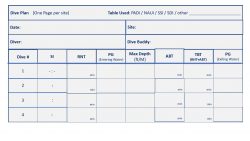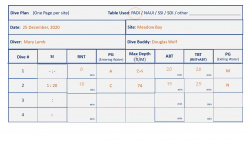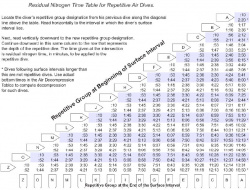Divetalking » Adv. Open Water, Article, Dive Planner, Divetalking, Education, Featured, Open Water, RDP, Reference, Training » RDP Plus – Properly Calculate Total Bottom Time on repetitive dives
RDP Plus – Properly Calculate Total Bottom Time on repetitive dives

One of the most common errors I witness as an Instructor is calculating the correct Total Bottom Time on the Recreational Dive Planner. The failure to add Residual Nitrogen Times to the Actual Bottom Time leaves the diver with an increasing accumulation of nitrogen in the body.
Why is this a problem?
It exposes the diver to the possibilities of Decompression Illness which could lead to serious harm to the diver.
Why is calculating Total Bottom Time important?
In order to minimize inadvertently and unknowingly augmenting residual nitrogen over the course of repetitive dives, the diver must be conscious of the residual nitrogen retained in the body after a period of surface interval and account for the residual nitrogen by factoring it into their Actual Bottom Time. Failure to account for the residual nitrogen results with the diver being at an increase risk of Decompression Sickness or Decompression Illness due to the increasing buildup of nitrogen stored in the body.
What is a Recreational Dive Planner, RDP?
The RDP is a tool used to assist “Recreational” divers plan dives so not to go into Decompression Dives.
What is Decompression Diving?
Divers who intentionally plan prolonged dives typically end up with enough nitrogen absorption in the body tissue they cannot safely make a direct ascent to the surface. They are obligated to pause their ascent at specified depths for specific periods of time before resuming their ascent. This is to facilitate the slow release of excess nitrogen in controlled stages to mitigate the chances of getting the bends, a form of DCI.
What is meant by Decompression?
Decompression is the act of pausing at a specific depth for a specified amount of time to facilitate off gassing excess nitrogen accumulated during the dive. “Recreational” diving allows a diver the option to go to the surface without having to make any obligatory stops along the way. When a diver exceeds a maximum time limit, they are obligated to make stops along the ascent, where they wait at specific depths for specific periods of time before resuming their ascent. A diver adhering to the times for recreational diving do not have this obligation of making required decompression stops.
What is Decompression Illness and Decompression Sickness?
Decompression illness, or DCI, is a term used to describe illness that results from a reduction in the ambient pressure surrounding a body. This is to say the pressure within the body is greater than that outside the body. This increase pressure within the body is a result of the absorption of nitrogen during a dive. We say the diver is Supersaturated when the amount of nitrogen in the body is greater than the amount the diver lives at, ie. Sea Level. DCI encompasses two diseases, decompression sickness (DCS) and arterial gas embolism (AGE).
Decompression Sickness, DCS is thought to result from bubbles growing in tissue and causing local damage.
Arterial Gas Embolism, AGE results from bubbles entering the lung circulation, traveling through the arteries and causing tissue damage at a distance by blocking (embolism) blood flow at the small vessel level.
What is Residual Nitrogen Time, RNT?
Residual nitrogen time (RNT) represents a theoretical amount of dissolved nitrogen that remain in your body tissues after a period of time. To simplify dive planning, residual nitrogen is calculated in minutes.
What is Actual Bottom Time, ABT?
The duration of elapsed time from the point of leaving the surface to begin a dive until beginning of a direct ascent to the surface.
What is Total Bottom Time, TBT?
The sum of the Actual Bottom Time plus Residual Nitrogen Time. It represents an amount of Nitrogen remaining in the diver’s body just prior to a subsequent dive.
What is No Decompression Limit, NDL?
The maximum allowable bottom time for any single dive. It is the maximum amount of dive time one may remain before going into decompression. Recreational divers should avoid exceeding the NDL.
What is Adjusted No Decompression Limit, ANDL?
The new maximum allowable bottom time when planning the ABT. It accounts for the residual nitrogen and subtract that from the NDL. It represents a maximum time one may remain at depth before going into decompression. Your ABT may not exceed the ANDL.
What is Pressure Group, PG?
A representation denoting an amount of accumulated Nitrogen in the body. It is used to determine time. For example how much time you must remain on the surface, how much time will you have on a dive.
At what point is TBT calculated?
If you follow, Plan your dive, Dive your plan the TBT is calculated at the time you plan your dive. It may also be planned at any point in time should the dive or the plan change. TBT is the sum of the RNT added to the ABT that is used to determine your pressure group at the end of a dive. In order to calculate your TBT, you will need to know what your Pressure Group is after a period of time is spent on the surface. The RNT is then added to the ABT of the dive about to occur or to the ABT after the dive has occurred.
The following examples will use the Diving Science and Technology RDP. This RDP is sanctioned by PADI. Later we will use another brand of RDP to compare.
Note: Once a term is defined and its acronym introduced, the acronym will be used more frequently throughout the article. For example, Total Bottom Time as TBT, Residual Nitrogen Time as RNT and so forth.
The next two images represent the two sides to the Diving Science and Technology RDP.
(Click on an image to expand its size)


Example of a Dive Plan form

The Scenario
Mary Lamb and Doug Wolf plan the following three dives at Meadow Bay.
- Dive #1 84 feet with a planned Actual Bottom Time of 20 minutes
- Dive #2 74 feet with a planned Actual Bottom Time of 15 minutes
- Dive #3 56 feet with a planned Actual Bottom Time of 30 minutes

Use the RDP shown above for the following examples
Dive #1 84 feet with a planned Actual Bottom Time of 20 minutes
Using Table 1 on the RDP, locate the Depth you plan to dive on the top of the RDP. If you do not find the exact depth listed, round up to the next higher depth. In this case, 90 feet.
Scan down the column under the 90 foot depth and look for 20 minutes. If you do not find the exact minute, round up to the next higher minute. In this case, 21 minutes.
Can you safely perform the planned dive #1?
It appears it is safe. Your planned time of 20 minutes falls short of the NDL for a dive to 87 feet where that limit is 25 minutes denoted by the number found in the black box at the bottom of the column below 90 feet. You also learn what your Exiting Pressure Group will be.
You now need to determine how much time you must spend out of the water, on your surface interval to support your second dive of 15 minutes to 74 feet.
( We will not cover in this article how to determine the surface interval time to support a 15 minute dive to 74 feet in this article. Will presume we have performed that calculation and continue with the articles point)
Scan across to the right towards table #2 remaining on the row for 21 minutes and you will come to an Alpha character. In this case, that character is M. M is the Pressure Group Designation at then end of a 20 minute dive to 87 feet, Dive #1.
Continue scanning to the right and you will find a box containing a range of numbers. Locate the box that contains the pair of numbers that include the surface time spend out of the water. The plan calls for a 1 hour and 20 minute surface interval. You will find a box containing  .This box represents a range from 1 hr and 5 minutes to 1 hr and 25 minutes which includes the planned 1:20 minute surface interval in its range. Follow the column under
.This box represents a range from 1 hr and 5 minutes to 1 hr and 25 minutes which includes the planned 1:20 minute surface interval in its range. Follow the column under  down to a new Pressure Group, C in this case.
down to a new Pressure Group, C in this case.
After spending 1 hour and 20 minutes on the surface you went from a Pressure Group of M to a Pressure Group of C. As a byproduct of the surface interval you have off gassed some amount of nitrogen. Table 3 will inform you of how much nitrogen remains in the body in the form of, time. Time that must be added to your next dives Actual Bottom Time.
Flip the card to table #3.

Use the RDP shown above for the following examples
Table #3 provides you with two sets of numbers. One surrounded by white, the other blue. The pair of numbers represent your RNT and your ANDL.
We know Dive #2 has a planned depth of 74 feet, ( Dive #2 74 feet with a planned Actual Bottom Time of 15 minutes ). When scanning the depths on the left side of table #3, if you do not find your exact depth, round up to the next higher/deeper depth. In this case, 80 feet will be used for discovering the RNT and ANDT.
You are looking for the pair of number that represent your RNT and ANDL. Scan across the row to the right of 80 feet to where the white/blue box intersects with the column for pressure group C.
You find a pair of numbers 10 over 20, depicted in the red box above.

The legend depicts the number found in the white box represents your RNT. The number found in the blue box represents your ANDL.
The RNT must be added to your ABT to determine your TBT. Knowing your TBT allows you to calculate your Pressure Group and in turn informing you of how much time you have.
When planning your next dive, your plan must not exceed the ANDL. In this case your ANDL is 20 minutes. Your ABT should not exceed your ANDL.
Dive #2 is to 74 feet with a planned Actual Bottom Time of 15 minutes
15 minutes does not exceed the 20 minute ANDL. It is OK to dive the planned 15 minutes. What if the ANDT value is less than your planned dive time, if your planned dive time was greater than the ANDL, what would you do? If the planned dive times equaled or exceeded the ANDL, you have a few choices available. 1) Extend your surface interval, 2) shorten the dive time, 3) dive a shallower depth 4) Dive Nitrox, or any combination of the choices.
Let us presume you dived your plan for dive #2.
To calculate your TBT, you would simply take the number found in the white box, 10 add it to your ABT, 15 resulting with 25 (10+15).
Moving back to table #1 on the RDP, scan down the column for the depth, 80 feet until you find 25 or the next highest number if your number is not displayed and you find the Pressure Group you are in at the end of dive #2. That Pressure Group is N.
The following picture shows what your Dive Log will look like after your second dive.

That is how you calculate the correct Total Bottom Time.
Now you try. The examples above have Mary and Doug completing Dive #2. Finish calculating what their Dive Log will look like after completing Dive #3 as planned.
Here is the plan for dive #3 for reference:
Dive #3 56 feet with a planned Actual Bottom Time of 30 minutes
When you think you have the Dive Plan complete Click HERE to see the Dive Plan. Don’t peek before completing the task..
Let’s summarize the steps.
- TBT after the first dive is simply the ABT since you have no residual nitrogen in your body.
- TBT after the second dive is RNT added to ABT.
- The RNT is found on table #3 and is located in the box containing the RNT and ANDL. You locate the box by intersecting the line for the planned depth of the next dive with the column for the PG after a surface interval from the previous dive and the RNT is the number found in the white box.
- The ANDL is also found at the intersection in the blue box. Your ABT may not exceed the ANDL. Now you know the absolute maximum time you may spend at depth. Your ABT should be less than the ANDL.
- Knowing the RNT before entering the water, you add the RNT to the ABT of the planned upcoming dive or after the dive to come up with the TBT.
- Your TBT should not exceed the Maximum time limit for the depth dived, which is denoted in the black box at the bottom of the column for the depth of the dive being calculated.
- Knowing your TBT you now know your PG after the end of dive.
U.S. Navy Dive Tables
Let’s repeat the three dive scenario this time using the U.S. Navy Dive Tables shown below. Using a piece of paper, create a Dive Plan, similar to the Dive Plan above filled out with all three dives found below.
Dive #1 84 feet with a planned Actual Bottom Time of 20 minutes
Dive #2 74 feet with a planned Actual Bottom Time of 15 minutes
Dive #3 56 feet with a planned Actual Bottom Time of 30 minutes



If you believe you have completed a correct Dive Plan for all three dives using the U.S. Navy Dive Table, Click HERE to view and compare the Dive Plan.
Does your Dive Plan match?
Other dive tables for our convenience. Using each of the provided Recreational Dive Planners below walk through the three dive scenario provided above. Completed Dive Plan for each of the RDP may be found just below each RDP.

Click HERE to see the Dive Plan for the SDI RDP above
Click HERE to see the Dive Plan for the SSI RDP above

Click HERE to see the Dive Plan for the NAUI RDP above
Dive Insurance
Read Is Dive Insurance Important? to learn more about why having Dive Insurance is Important.
© 2020 – 2021, admin. All rights reserved.
Filed under: Adv. Open Water, Article, Dive Planner, Divetalking, Education, Featured, Open Water, RDP, Reference, Training · Tags: Diving Science and Technology, NAUI RDP, PADI RDP, RDP, Recreational Dive Planner, SDI RDP, SSI RDP












